Do you remember when Saturday mornings actually meant something?
When you’d grab your cereal, park yourself in front of the TV, and disappear into a pixel-packed world where your favorite game characters talked, teamed up, and took on evil together? If that memory just hit you like a power-up block, then yeah, you're in the right place.
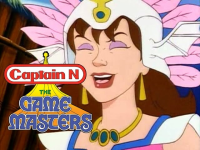
You’re probably thinking, “Captain N was kinda cheesy… but man, I loved every minute of it.” And you’re not alone. We all knew the animation was clunky, the characters were nothing like their game versions, and Game Boy sounded like a broken calculator.
But guess what? We didn’t care. Because when you’re 9 and your TV turns into a warp zone full of Nintendo heroes, that’s magic. Pure magic.
So if you’ve ever tried to explain Captain N to someone younger and got that blank stare, don’t worry. We get it. That show was a vibe. A bizarre, brilliant, unforgettable mash-up of everything we loved about gaming before “canon” and “continuity” started getting in the way of fun.
We’re gonna crack open the Power Pad on this one and relive it all, from Kevin Keene’s accidental heroism to that sassy Mother Brain. Ready to plug back in?
Let’s begin.
Back in the late 1980s, Nintendo was more than just a gaming company.
It was a cultural earthquake. Kids were trading cheat codes on playgrounds, magazines like Nintendo Power were flying off shelves, and game consoles were quickly becoming household essentials. If you were a kid during this era, Nintendo wasn’t just something you played. It was your world.
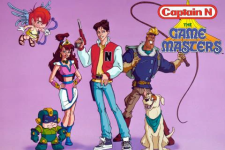
So it’s no surprise that TV execs started sniffing around. If Mario and Link could dominate your living room, why not Saturday mornings too? That’s where Captain N: The Game Master comes in—a bold, weird, and totally ambitious idea that mashed together video games and cartoons into one glorious, pixelated spectacle.
But here's the twist. Captain N wasn’t dreamed up by Nintendo itself.
It came from DIC Entertainment, the same animation house responsible for shows like Inspector Gadget and The Real Ghostbusters. The concept actually began as a comic strip pitch in Nintendo Power magazine—yes, that magazine your older cousin wouldn’t let you borrow. It featured a regular teenager being sucked into his Nintendo, where he’d become a hero among game characters. Sound familiar?
That seed eventually grew into a full-fledged animated series that aired on NBC from 1989 to 1991. It had the backing of Nintendo’s licensing arm, but the execution? That was all Western animation flair, mixed with a deep misunderstanding (or total reimagining) of the source material.
The animation quality was what you'd expect for the time: low-budget, quick-turnaround, and often completely inconsistent. Characters looked off-model. Physics made no sense. And plotlines jumped around like a kid hopped up on Kool-Aid. But you know what? It worked. Somehow, in spite of everything, it worked.
The real magic of Captain N wasn’t in technical perfection. It was in the timing.
It hit at the exact moment when Nintendo ruled the world, and kids were desperate to see their favorite characters off the screen and into stories. Mega Man talking like a raspy gremlin? Weird. Simon Belmont as a vain, mirror-obsessed diva? We rolled with it. Because the show gave us something no game could at the time: it brought the characters to life.
This was before Super Smash Bros., before deep-cut lore videos on YouTube, before anyone cared if a cartoon was canon. In that way, Captain N was ahead of its time—sprawling, chaotic, and unapologetically playful.
The idea was simple but genius. Take a regular kid, Kevin Keene, and his dog Duke. Suck them into “Videoland” through a warp zone, hand him a zapper gun and a Power Pad belt, and surround him with misfit versions of popular characters. Then let them battle villains like Mother Brain, King Hippo, and Eggplant Wizard. It was part fan fiction, part fever dream.
And yet, it stuck. It hit a nerve. It made a generation of gamers believe, even for a moment, that one day they too could get pulled into their console and become the hero.
Some were barely recognizable. Others were twisted into strange, exaggerated caricatures. And yet, that’s part of the charm. And it created a strange little family that, for better or worse, we got attached to.
Let’s break them down.
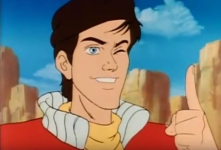
The all-American high school kid from Northridge, California. He’s your typical 80s protagonist: brave, humble, slightly clueless, and always ready to do the right thing. Kevin gets pulled into Videoland through his TV and ends up wearing a varsity jacket, armed with a NES Zapper and a Power Pad belt. No real backstory, no training montage, just instant hero status.
Compared to modern game protagonists? Kevin feels almost too wholesome. There’s no angst, no emotional baggage, no inner conflict. He’s not Joel from The Last of Us, not Geralt from The Witcher, and definitely not anything close to today’s edgy anti-heroes. But that’s why he worked back then. He was you. The fantasy of being sucked into your favorite games wasn’t just about the world—it was about you becoming the hero. Simple. Direct. And kind of brilliant.
Lana is smart, competent, and acts as the glue holding the team together. She’s also the love interest, though that angle never really goes anywhere beyond mild flirting.
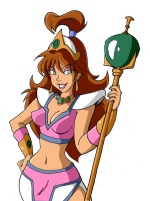
Image credit: Fandom
In a time when most animated princesses were either damsels or window dressing, Lana stood out. She led missions. She gave orders. She wasn’t there to be rescued—she was already in charge. Think of her as a proto-Zelda from Breath of the Wild, but with way fewer cutscenes and zero swordplay.
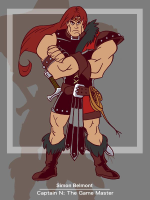
It’s wild. Today’s Simon is stoic, grim, and battle-worn. But back then? He was comic relief. And while it annoyed some fans even then, it gave the show a goofy charm. He was a parody of action heroes—think Johnny Bravo meets Indiana Jones. A total detour from the games, but somehow it worked in the group dynamic.
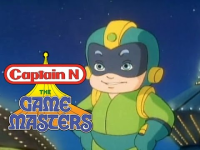
Game-wise, Mega Man was a sleek, silent robot hero fighting for justice in a high-tech world. In Captain N, he’s more like the weird little brother who keeps trying to prove himself. Compared to modern versions, especially from the Mega Man Zero or Mega Man X series, this one feels like a totally different species.
But again, context matters. The show wasn’t trying to capture the lore. It was riffing off what little personality had been shown in the games and cranking it up to 11. The “mega-everything” talk? Annoying today, but back then, it gave him a distinct voice—literally and figuratively.
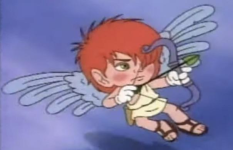
But underneath the verbal tic was a kind-hearted, loyal teammate. In a weird way, he filled the “innocent voice of reason” role. Today’s Pit, especially in the Super Smash Bros. series, is far more polished and expressive, but the Captain N version has this scrappy charm. He’s more sidekick than warrior, more comic relief than legend. But he’s consistent. And in a show full of randomness, that counted for something.
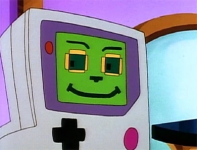
It’s clear Game Boy was more about marketing than storytelling. He existed to promote the actual handheld console. And while he didn’t add much depth, he was a constant reminder that the Game Boy was the next big thing—and you probably wanted one.
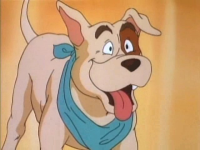
If Captain N were made today, Duke would probably have a full backstory, a tragic past, and some hidden ability unlocked in the finale. But in the show, he was just Duke. And that was enough.
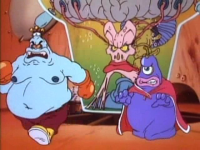
Her henchmen? King Hippo from Punch-Out!! and Eggplant Wizard from Kid Icarus.
They were dumb, clumsy, and totally useless, but funny. It was a classic cartoon villainy. These weren’t menacing threats. They were roadblocks. Comedy props. The Wile E. Coyotes of Videoland.
Today’s villains are often nuanced and tragic. Back then, they were just loud and weird, and we loved it.
The game worlds were mashed together, geography was nonsense, and physics barely existed. But that was the point. Videoland was a patchwork of imagination, stitched together from cartridges and childhood wish lists.
Let’s look closer at the layout and the subtle (and not-so-subtle) winks to the gamers watching.
These worlds were connected by warp zones, skyways, and portals that appeared with little logic but endless excitement. You never knew where the gang would end up next, and that unpredictability made it feel alive.
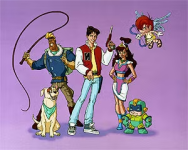
There wasn’t an actual map, but key areas returned often:
Look closely, and Captain N was full of little treats for fans.
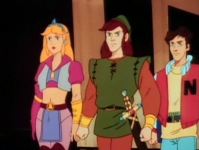
It’s easy to criticize the show for being loose with its source material. But remember, most of these games had little to no backstory. The characters barely talked. There were no cutscenes, no lore books, no 300-page wikis. Captain N took vague concepts and turned them into living, breathing (and occasionally bonkers) places.
And if you're wondering why Mario or Luigi didn’t show up? Different licensing deal. They had their own show. Same with Zelda. So Captain N had to get creative. And honestly, that made it more interesting. It forced the creators to reimagine things. To experiment. To remix.
In a way, Videoland was fanfiction before fanfiction blew up.
But if you were a kid in 1990, it didn’t need to. The show wasn’t about flawless plots or deep character arcs. It was about adventure. Teamwork. And seeing your favorite game heroes in situations that were often goofy, sometimes clever, and always full of heart.
Still, beneath all the zany plots and pixel references, the show had its own rhythm, and even a few surprising themes that hit harder than they had any right to.
Examples?
But for a show built around selling Nintendo games, it had more soul than it needed to. It knew what it was—and leaned into it without ever taking itself too seriously.
Today, we’ve got Super Smash Bros., Wreck-It Ralph, and Ready Player One. Giant mashups. Corporate-approved fan service. But Captain N was doing this decades earlier, with a smaller budget, weirder animation, and way more personality.
No multiverse logic. No lore books. Just characters from different games, sharing screen time like it was the most natural thing in the world.
It was chaotic. It was awkward. And it worked.
Because at the end of the day, it wasn’t about the logic. It was about the feeling, of turning on the TV and seeing the impossible happen. Watching Mega Man crack jokes next to Simon Belmont.
Hearing a Power Glove actually do something cool. Cheering as Kevin figured out another way to beat the odds.
Yes, that Mother Brain from Metroid.
But forget the eerie, pulsating bio-monster in a glass jar. This version? She talked like a sassy diva, floated around in a tank, and ran her evil empire like a gossip queen with a control complex.
If you were a kid back then, you either feared her, laughed at her, or didn’t know what to make of her.
Let’s break it down.
She ruled from her lair in Metroid, barking orders, scheming wild plans, and often mocking her own minions when things fell apart.
She wasn’t physically imposing, but her personality filled the screen. She used manipulation over muscle, always plotting some over-the-top scheme to conquer Videoland or destroy Captain N. Honestly, she felt like a cartoon mashup of Ursula from The Little Mermaid and Dr. Evil from Austin Powers.
Think Hades from Disney’s Hercules, a villain who talks more than fights, but steals every scene.
But in this version, he wasn’t the tough, silent boxer you may remember. He was… dumb. Like, cartoonishly dumb.
He was huge, strong, and incredibly loyal, but always a few seconds behind in any conversation. Most of his scenes ended in some form of slapstick failure.
Fall through a trapdoor? Check.
Punch himself in the face? Check.
Fail to carry out even the simplest of missions? Absolutely.
But as goofy as he was, you couldn’t help but root for him just a little. He tried. He showed up. And he had a weird kind of charm, like a big kid who accidentally joined the villain squad.
Just like Kronk from The Emperor’s New Groove. Buff, lovable, and completely clueless.
He literally threw vegetables as weapons. Let that sink in.
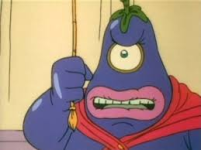
He talked like a vaudeville comic, pulled absurd food-related gadgets out of thin air, and had a thing for disguises that never worked. He was basically a one-man kitchen disaster.
But don’t let the jokes fool you, he was persistent. And when paired with King Hippo, they made the perfect odd couple: one big, one shrill, both completely ineffective.
Closest match? Team Rocket from Pokémon. Their plans always failed, but somehow they stuck around. And you’d feel weird if they didn’t.
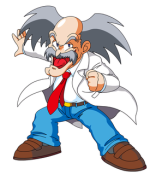
He built machines to destroy Captain N, hack into Videoland, or hijack game worlds. Sometimes they worked. Most times? Not so much.
He was smarter than Hippo and Eggplant, but his ego got in the way. And like most cartoon villains, he couldn’t resist monologuing long enough to win. Think Doofenshmirtz from Phineas and Ferb, only with slightly more menace and slightly less self-awareness.
The genius (and chaos) of Captain N was that it never took itself too seriously. The villains were big, bold, and borderline absurd—but somehow, it worked. And if you're honest, you'd admit that you kinda loved them for it.
Maybe it was a random YouTube clip, or the smell of an old Nintendo cartridge that brought it all back. Saturday mornings. Cereal bowls. That fuzzy feeling of getting lost in a cartoon that somehow made my favorite games feel real.
Yeah, that hit me right in the feels. And if you're feeling it too, you're not alone.
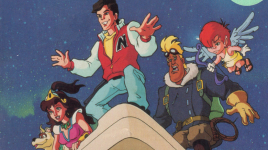
I wasn’t just watching a show. I was jumping into a world where Mega Man cracked weird jokes, Simon Belmont acted like a drama queen, and Mother Brain ran the show with full diva energy. It was wild. It was ridiculous. And it was perfect. For a few moments each week, I felt like I was part of something bigger. Like I had a backstage pass into the worlds I already loved.
And yeah, I still watch it sometimes. Maybe you do too.
Maybe you’ve got a secret folder of old episodes, or you hum the theme song without even realizing it. That’s not childish. That’s powerful. That’s memory doing what it does best.
This wasn’t just a cartoon. It was a spark. It reminded me that stories could stretch across dimensions, that anything could happen, and that a regular kid could be a hero. That’s the magic that pulled me in then, and it’s the magic I still carry with me now.
So if this article brought any of that back for you, even for a second, then I’m glad we took this trip together. It’s easy to forget how good those days were. But now? Now we remember. Now we feel it.
I say keep that controller close. Keep that joy even closer. Because the best worlds are the ones we never really leave.
What are your personal childhood memories of Captain N: The Game Master? Did you love the game?
When you’d grab your cereal, park yourself in front of the TV, and disappear into a pixel-packed world where your favorite game characters talked, teamed up, and took on evil together? If that memory just hit you like a power-up block, then yeah, you're in the right place.

You’re probably thinking, “Captain N was kinda cheesy… but man, I loved every minute of it.” And you’re not alone. We all knew the animation was clunky, the characters were nothing like their game versions, and Game Boy sounded like a broken calculator.
But guess what? We didn’t care. Because when you’re 9 and your TV turns into a warp zone full of Nintendo heroes, that’s magic. Pure magic.
So if you’ve ever tried to explain Captain N to someone younger and got that blank stare, don’t worry. We get it. That show was a vibe. A bizarre, brilliant, unforgettable mash-up of everything we loved about gaming before “canon” and “continuity” started getting in the way of fun.
We’re gonna crack open the Power Pad on this one and relive it all, from Kevin Keene’s accidental heroism to that sassy Mother Brain. Ready to plug back in?
Let’s begin.
How Did This Even Get Made?
A Look at the Origins and Background of Captain N: The Game MasterBack in the late 1980s, Nintendo was more than just a gaming company.
It was a cultural earthquake. Kids were trading cheat codes on playgrounds, magazines like Nintendo Power were flying off shelves, and game consoles were quickly becoming household essentials. If you were a kid during this era, Nintendo wasn’t just something you played. It was your world.

So it’s no surprise that TV execs started sniffing around. If Mario and Link could dominate your living room, why not Saturday mornings too? That’s where Captain N: The Game Master comes in—a bold, weird, and totally ambitious idea that mashed together video games and cartoons into one glorious, pixelated spectacle.
But here's the twist. Captain N wasn’t dreamed up by Nintendo itself.
It came from DIC Entertainment, the same animation house responsible for shows like Inspector Gadget and The Real Ghostbusters. The concept actually began as a comic strip pitch in Nintendo Power magazine—yes, that magazine your older cousin wouldn’t let you borrow. It featured a regular teenager being sucked into his Nintendo, where he’d become a hero among game characters. Sound familiar?
That seed eventually grew into a full-fledged animated series that aired on NBC from 1989 to 1991. It had the backing of Nintendo’s licensing arm, but the execution? That was all Western animation flair, mixed with a deep misunderstanding (or total reimagining) of the source material.
The animation quality was what you'd expect for the time: low-budget, quick-turnaround, and often completely inconsistent. Characters looked off-model. Physics made no sense. And plotlines jumped around like a kid hopped up on Kool-Aid. But you know what? It worked. Somehow, in spite of everything, it worked.
The real magic of Captain N wasn’t in technical perfection. It was in the timing.
It hit at the exact moment when Nintendo ruled the world, and kids were desperate to see their favorite characters off the screen and into stories. Mega Man talking like a raspy gremlin? Weird. Simon Belmont as a vain, mirror-obsessed diva? We rolled with it. Because the show gave us something no game could at the time: it brought the characters to life.
This was before Super Smash Bros., before deep-cut lore videos on YouTube, before anyone cared if a cartoon was canon. In that way, Captain N was ahead of its time—sprawling, chaotic, and unapologetically playful.
The idea was simple but genius. Take a regular kid, Kevin Keene, and his dog Duke. Suck them into “Videoland” through a warp zone, hand him a zapper gun and a Power Pad belt, and surround him with misfit versions of popular characters. Then let them battle villains like Mother Brain, King Hippo, and Eggplant Wizard. It was part fan fiction, part fever dream.
And yet, it stuck. It hit a nerve. It made a generation of gamers believe, even for a moment, that one day they too could get pulled into their console and become the hero.
Captain N: The Game Master Characters
Let’s be honest. The characters in Captain N weren’t exactly faithful to the games they came from.Some were barely recognizable. Others were twisted into strange, exaggerated caricatures. And yet, that’s part of the charm. And it created a strange little family that, for better or worse, we got attached to.
Let’s break them down.
Kevin Keene (a.k.a. Captain N)

The all-American high school kid from Northridge, California. He’s your typical 80s protagonist: brave, humble, slightly clueless, and always ready to do the right thing. Kevin gets pulled into Videoland through his TV and ends up wearing a varsity jacket, armed with a NES Zapper and a Power Pad belt. No real backstory, no training montage, just instant hero status.
Compared to modern game protagonists? Kevin feels almost too wholesome. There’s no angst, no emotional baggage, no inner conflict. He’s not Joel from The Last of Us, not Geralt from The Witcher, and definitely not anything close to today’s edgy anti-heroes. But that’s why he worked back then. He was you. The fantasy of being sucked into your favorite games wasn’t just about the world—it was about you becoming the hero. Simple. Direct. And kind of brilliant.
Princess Lana
The ruler of Videoland and the show’s only original character who wasn’t based on a game.Lana is smart, competent, and acts as the glue holding the team together. She’s also the love interest, though that angle never really goes anywhere beyond mild flirting.

Image credit: Fandom
In a time when most animated princesses were either damsels or window dressing, Lana stood out. She led missions. She gave orders. She wasn’t there to be rescued—she was already in charge. Think of her as a proto-Zelda from Breath of the Wild, but with way fewer cutscenes and zero swordplay.
Simon Belmont (Castlevania)
Brace yourself. If your only experience with Simon Belmont is from Castlevania or Super Smash Bros., this version might sting. In Captain N, Simon is a preening, egotistical, mirror-loving blowhard who’s more interested in his reflection than slaying vampires.
It’s wild. Today’s Simon is stoic, grim, and battle-worn. But back then? He was comic relief. And while it annoyed some fans even then, it gave the show a goofy charm. He was a parody of action heroes—think Johnny Bravo meets Indiana Jones. A total detour from the games, but somehow it worked in the group dynamic.
Mega Man
Oh boy. This one’s infamous. In the show, Mega Man is short, squat, green (yes, green), and raspy. He refers to everything as “mega”: “Mega-fun,” “Mega-problem,” “Mega-bummer.” It’s endearing… if you were seven.
Game-wise, Mega Man was a sleek, silent robot hero fighting for justice in a high-tech world. In Captain N, he’s more like the weird little brother who keeps trying to prove himself. Compared to modern versions, especially from the Mega Man Zero or Mega Man X series, this one feels like a totally different species.
But again, context matters. The show wasn’t trying to capture the lore. It was riffing off what little personality had been shown in the games and cranking it up to 11. The “mega-everything” talk? Annoying today, but back then, it gave him a distinct voice—literally and figuratively.
Kid Icarus (a.k.a. Pit)
This one’s actually kind of lovable. Pit, or “Kid Icarus,” as they called him, was the small, winged archer who spoke in sing-song riddles and annoyingly added “-icus” to every word. “That’s danger-icus!” “Let’s hurry-icus!” It was a lot.
But underneath the verbal tic was a kind-hearted, loyal teammate. In a weird way, he filled the “innocent voice of reason” role. Today’s Pit, especially in the Super Smash Bros. series, is far more polished and expressive, but the Captain N version has this scrappy charm. He’s more sidekick than warrior, more comic relief than legend. But he’s consistent. And in a show full of randomness, that counted for something.
Game Boy
A walking, talking Game Boy with arms and legs, introduced in Season 2. Created by Dr. Wright, he mostly spouted robotic logic and comic misunderstandings. Imagine R2-D2 mixed with a Tamagotchi and a cheap calculator. That’s Game Boy.
It’s clear Game Boy was more about marketing than storytelling. He existed to promote the actual handheld console. And while he didn’t add much depth, he was a constant reminder that the Game Boy was the next big thing—and you probably wanted one.
Duke (Kevin’s Dog)
The unsung hero of the show. Duke was loyal, brave, and often saved the day without needing gadgets or special powers. Just a regular dog in a digital world, navigating warp zones like it was no big deal.
If Captain N were made today, Duke would probably have a full backstory, a tragic past, and some hidden ability unlocked in the finale. But in the show, he was just Duke. And that was enough.
Mother Brain, King Hippo, and Eggplant Wizard (The Villains)
Mother Brain was the big bad. Loosely based on Metroid, but reimagined as a sassy, scheming, lipsticked blob of evil. Think Little Shop of Horrors meets Ursula from The Little Mermaid, and you’re close.
Her henchmen? King Hippo from Punch-Out!! and Eggplant Wizard from Kid Icarus.
They were dumb, clumsy, and totally useless, but funny. It was a classic cartoon villainy. These weren’t menacing threats. They were roadblocks. Comedy props. The Wile E. Coyotes of Videoland.
Today’s villains are often nuanced and tragic. Back then, they were just loud and weird, and we loved it.
Inside Videoland: Settings, Worlds, and Nintendo Easter Eggs
If you've ever wished you could jump into your favorite NES game, Captain N made that dream feel strangely real. Sure, it didn’t always follow the rules.The game worlds were mashed together, geography was nonsense, and physics barely existed. But that was the point. Videoland was a patchwork of imagination, stitched together from cartridges and childhood wish lists.
Let’s look closer at the layout and the subtle (and not-so-subtle) winks to the gamers watching.
Videoland: The Multiverse Before the Multiverse Was Cool
Videoland was presented as an entire universe made up of “video worlds,” each based on different Nintendo games.These worlds were connected by warp zones, skyways, and portals that appeared with little logic but endless excitement. You never knew where the gang would end up next, and that unpredictability made it feel alive.

There wasn’t an actual map, but key areas returned often:
- Megaland [Mega Man’s world]: A techno-heavy dystopia full of robots and neon danger. Not quite like the levels you played on the NES, but the vibe was there, just exaggerated for cartoon fun.
- Castlevania [Home of Simon Belmont]: Spooky, Gothic, and crawling with ghouls. Think Dracula’s Castle with fewer bloodsuckers and more Saturday morning color palettes.
- Mount Icarus [Kid Icarus’s domain]: Floating islands, ancient ruins, and pastel skies. It was a whimsical version of Greek mythology, with just enough detail to remind you of the original.
- Metroid-based areas: Rarely shown in full, but Mother Brain’s lair seemed like a twisted version of Zebes, dripping with goo, echoing with evil, and glowing like a lava lamp gone rogue.
Easter Eggs You May Have Missed
Look closely, and Captain N was full of little treats for fans.
- Warp zones worked just like in Super Mario Bros., but instead of pipes, you had glowing portals that zapped the team into new worlds.
- The Power Glove wasn’t just a product, Mother Brain used it. Yeah, the actual villain used the most hyped (and least functional) Nintendo accessory as a weapon of mass destruction. If you missed that as a kid, you weren’t alone.
- Names and phrases were dropped all the time. “Game Over,” “Bonus Levels,” “Extra Lives”, they weren’t just gaming lingo, they were used as plot points.
- Cameos galore: From Donkey Kong rampaging through a level to Link and Zelda dropping by for a guest appearance, Captain N casually brought in big names. Not always accurately. Not always gracefully. But they showed up.

It’s easy to criticize the show for being loose with its source material. But remember, most of these games had little to no backstory. The characters barely talked. There were no cutscenes, no lore books, no 300-page wikis. Captain N took vague concepts and turned them into living, breathing (and occasionally bonkers) places.
And if you're wondering why Mario or Luigi didn’t show up? Different licensing deal. They had their own show. Same with Zelda. So Captain N had to get creative. And honestly, that made it more interesting. It forced the creators to reimagine things. To experiment. To remix.
In a way, Videoland was fanfiction before fanfiction blew up.
When Saturday Morning Cartoons Met 8-Bit Icons: Storytelling, Plots, and Themes
Let’s be real: Captain N didn’t win any awards for writing.But if you were a kid in 1990, it didn’t need to. The show wasn’t about flawless plots or deep character arcs. It was about adventure. Teamwork. And seeing your favorite game heroes in situations that were often goofy, sometimes clever, and always full of heart.
Still, beneath all the zany plots and pixel references, the show had its own rhythm, and even a few surprising themes that hit harder than they had any right to.
Episode Plots That Threw Logic Out the Window
Every episode followed a familiar loop: the N Team faced a new threat, got separated, got zapped into a new world, reunited, and then defeated the baddies (usually Mother Brain) through luck, gadgets, or last-second teamwork.Examples?
- “Kevin in Videoland” [Pilot]: Kevin gets sucked into his TV during a game session. One minute he’s chilling with his dog Duke, next minute he’s dodging laser blasts with Mega Man and Simon. No explanation, no prep time. Just vibes.
- “Nightmare on Mother Brain’s Street”: A straight-up spoof of Nightmare on Elm Street, complete with dream sequences, creepy villains, and a surprisingly dark atmosphere. For a kids’ cartoon, it leaned into horror tropes more than expected.
- “Wishful Thinking”: Kid Icarus gets a magic lamp and makes wishes that go sideways. Classic cartoon setup, but the twist? The wishes start affecting game logic, like turning power-ups into traps.
Themes You Didn’t Notice as a Kid
On the surface, Captain N was just another action cartoon. But dig a little deeper, and a few recurring themes start to stand out:- Belonging: Kevin was a regular teen in a strange world. Every episode wrestled, in small ways, with feeling out of place. He was from Earth. He wasn’t a game character. Yet he constantly proved himself as a leader. For kids who felt like outsiders? That mattered.
- Identity and stereotypes: Each character leaned into tropes—Simon was the narcissist, Mega Man the loyal sidekick, Kid Icarus the naive optimist—but over time, those tropes got played with. Simon’s cowardice got flipped into bravery. Mega Man's “YES, MEGA!” confidence masked real loyalty. They weren’t just one-note.
- Technology vs. humanity: Mother Brain wanted domination through control and machines. The N Team fought back with creativity, emotion, and unpredictability. It wasn’t preachy, but it was a recurring tension—especially in episodes with Game Boy, who often struggled to understand emotion or humor.
But for a show built around selling Nintendo games, it had more soul than it needed to. It knew what it was—and leaned into it without ever taking itself too seriously.
Today, we’ve got Super Smash Bros., Wreck-It Ralph, and Ready Player One. Giant mashups. Corporate-approved fan service. But Captain N was doing this decades earlier, with a smaller budget, weirder animation, and way more personality.
No multiverse logic. No lore books. Just characters from different games, sharing screen time like it was the most natural thing in the world.
It was chaotic. It was awkward. And it worked.
Because at the end of the day, it wasn’t about the logic. It was about the feeling, of turning on the TV and seeing the impossible happen. Watching Mega Man crack jokes next to Simon Belmont.
Hearing a Power Glove actually do something cool. Cheering as Kevin figured out another way to beat the odds.
The Villains of Videoland: Mother Brain and Her Goofy Gallery of Henchmen
Every good hero team needs a great villain; and Captain N delivered one that was equal parts nightmare fuel and Saturday morning camp: Mother Brain.Yes, that Mother Brain from Metroid.
But forget the eerie, pulsating bio-monster in a glass jar. This version? She talked like a sassy diva, floated around in a tank, and ran her evil empire like a gossip queen with a control complex.
If you were a kid back then, you either feared her, laughed at her, or didn’t know what to make of her.
Let’s break it down.
Mother Brain: The Sass Queen of Evil
Voiced by the legendary Levi Stubbs (lead singer of The Four Tops, by the way), Mother Brain’s voice was theatrical, loud, and packed with attitude.She ruled from her lair in Metroid, barking orders, scheming wild plans, and often mocking her own minions when things fell apart.
She wasn’t physically imposing, but her personality filled the screen. She used manipulation over muscle, always plotting some over-the-top scheme to conquer Videoland or destroy Captain N. Honestly, she felt like a cartoon mashup of Ursula from The Little Mermaid and Dr. Evil from Austin Powers.
Think Hades from Disney’s Hercules, a villain who talks more than fights, but steals every scene.
King Hippo: Brains Not Included
Straight outta Punch-Out!!, King Hippo was one of Mother Brain’s main henchmen.But in this version, he wasn’t the tough, silent boxer you may remember. He was… dumb. Like, cartoonishly dumb.
He was huge, strong, and incredibly loyal, but always a few seconds behind in any conversation. Most of his scenes ended in some form of slapstick failure.
Fall through a trapdoor? Check.
Punch himself in the face? Check.
Fail to carry out even the simplest of missions? Absolutely.
But as goofy as he was, you couldn’t help but root for him just a little. He tried. He showed up. And he had a weird kind of charm, like a big kid who accidentally joined the villain squad.
Just like Kronk from The Emperor’s New Groove. Buff, lovable, and completely clueless.
Eggplant Wizard: Walking Food Fight
Another of Mother Brain’s loyal goons, Eggplant Wizard hailed from Kid Icarus. And just like King Hippo, his portrayal was more punchline than powerhouse.He literally threw vegetables as weapons. Let that sink in.

He talked like a vaudeville comic, pulled absurd food-related gadgets out of thin air, and had a thing for disguises that never worked. He was basically a one-man kitchen disaster.
But don’t let the jokes fool you, he was persistent. And when paired with King Hippo, they made the perfect odd couple: one big, one shrill, both completely ineffective.
Closest match? Team Rocket from Pokémon. Their plans always failed, but somehow they stuck around. And you’d feel weird if they didn’t.
Dr. Wily: Mad Science on a Budget
Unlike his other villain co-stars, Dr. Wily (Mega Man’s archnemesis) was actually competent, at least on paper. In Captain N, he had the lab coat, the wild hair, the German-ish accent, and a never-ending supply of evil gadgets and robots.
He built machines to destroy Captain N, hack into Videoland, or hijack game worlds. Sometimes they worked. Most times? Not so much.
He was smarter than Hippo and Eggplant, but his ego got in the way. And like most cartoon villains, he couldn’t resist monologuing long enough to win. Think Doofenshmirtz from Phineas and Ferb, only with slightly more menace and slightly less self-awareness.
The Real Enemy? Cartoon Logic
Here’s the thing: none of these villains were really scary. Not even close. But they weren’t meant to be. They were there to create stakes, give the heroes something to rally against, and make kids laugh along the way.The genius (and chaos) of Captain N was that it never took itself too seriously. The villains were big, bold, and borderline absurd—but somehow, it worked. And if you're honest, you'd admit that you kinda loved them for it.
Why I Still Smile When I Think About Captain N
Maybe I didn’t even realize how much I missed it until now.Maybe it was a random YouTube clip, or the smell of an old Nintendo cartridge that brought it all back. Saturday mornings. Cereal bowls. That fuzzy feeling of getting lost in a cartoon that somehow made my favorite games feel real.
Yeah, that hit me right in the feels. And if you're feeling it too, you're not alone.

I wasn’t just watching a show. I was jumping into a world where Mega Man cracked weird jokes, Simon Belmont acted like a drama queen, and Mother Brain ran the show with full diva energy. It was wild. It was ridiculous. And it was perfect. For a few moments each week, I felt like I was part of something bigger. Like I had a backstage pass into the worlds I already loved.
And yeah, I still watch it sometimes. Maybe you do too.
Maybe you’ve got a secret folder of old episodes, or you hum the theme song without even realizing it. That’s not childish. That’s powerful. That’s memory doing what it does best.
This wasn’t just a cartoon. It was a spark. It reminded me that stories could stretch across dimensions, that anything could happen, and that a regular kid could be a hero. That’s the magic that pulled me in then, and it’s the magic I still carry with me now.
So if this article brought any of that back for you, even for a second, then I’m glad we took this trip together. It’s easy to forget how good those days were. But now? Now we remember. Now we feel it.
I say keep that controller close. Keep that joy even closer. Because the best worlds are the ones we never really leave.
What are your personal childhood memories of Captain N: The Game Master? Did you love the game?

